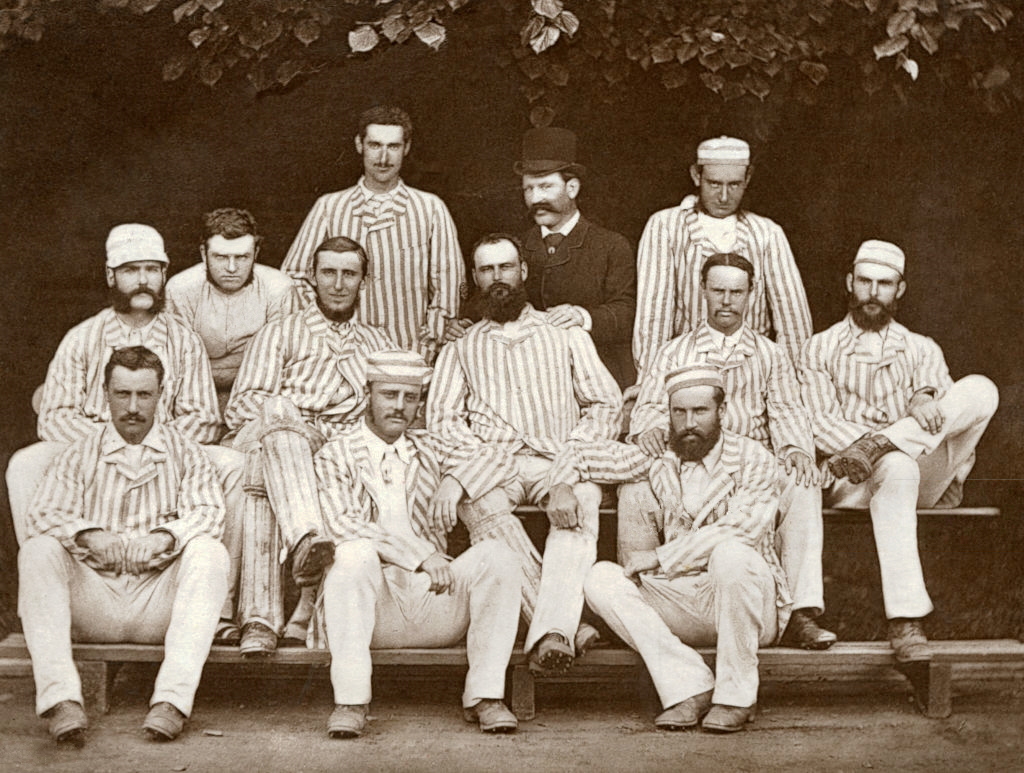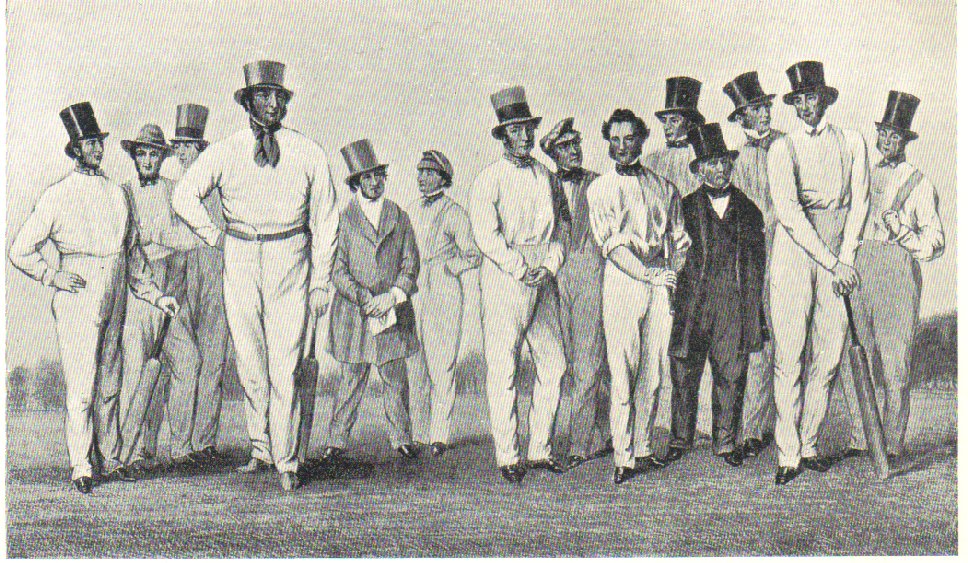|
1926 English Cricket Season
1926 was the 33rd season of County Championship cricket in England. England regained the Ashes and Lancashire won the championship. Honours *County Championship - Lancashire *Minor Counties Championship - Durham *Wisden - George Geary, Harold Larwood, Jack Mercer, Bert Oldfield, Bill Woodfull Test series England regained the Ashes by winning the final Test at The Oval after the first four matches against Australia were all drawn. Because the series was at stake, the match was to be "timeless", i.e. played to a finish. Australia had a narrow first innings lead of 22. Jack Hobbs and Herbert Sutcliffe took the score to 49–0 at the end of the second day, a lead of 27. Heavy rain fell overnight, and next day the pitch soon developed into a traditional sticky wicket. England seemed doomed to be bowled out cheaply and to lose the match. In spite of the very difficult batting conditions, however, Hobbs and Sutcliffe took their partnership to 172 before Hobbs was out for exactly 100. ... [...More Info...] [...Related Items...] OR: [Wikipedia] [Google] [Baidu] |
County Championship
The County Championship (referred to as the LV= Insurance County Championship for sponsorship reasons) is the domestic first-class cricket competition in England and Wales and is organised by the England and Wales Cricket Board (ECB). It became an official title in 1890. The competition consists of eighteen clubs named after, and representing historic counties, seventeen from England and one from Wales. The earliest known inter-county match was played in 1709. Until 1889, the concept of an unofficial county championship existed whereby various claims would be made by or on behalf of a particular club as the "Champion County", an archaic term which now has the specific meaning of a claimant for the unofficial title prior to 1890. In contrast, the term "County Champions" applies in common parlance to a team that has won the official title. The most usual means of claiming the unofficial title was by popular or press acclaim. In the majority of cases, the claim or proclamation w ... [...More Info...] [...Related Items...] OR: [Wikipedia] [Google] [Baidu] |
Herbert Sutcliffe
Herbert Sutcliffe (24 November 1894 – 22 January 1978) was an English professional cricketer who represented Yorkshire and England as an opening batsman. Apart from one match in 1945, his first-class career spanned the period between the two world wars. His first-class debut was delayed by the First World War until 1919 and his career was effectively terminated in August 1939 when he was called up for military service in the imminent Second World War. He was the first cricketer to score 16 centuries in Test match cricket.He is most famous for being the partner of Jack Hobbs and the partnership between the two,Hobbs and Sutcliffe is widely regarded as the greatest partnership of all time. A right-handed batsman, Sutcliffe was noted for his concentration and determination, qualities which made him invaluable to his teams in adverse batting conditions; and he is remembered as one of the game's finest "bad wicket batsmen". His fame rests mainly in the great opening partnership ... [...More Info...] [...Related Items...] OR: [Wikipedia] [Google] [Baidu] |
Irving Rosenwater
Irving Rosenwater (11 September 1932 – 30 January 2006) was an English cricket researcher and author whose best-known work was '' Sir Donald Bradman - A Biography'' (1978). Born in the East End of London to jewish parents of Polish origin, Rosenwater initially had two birth certificates. The first registered him as "Isidore", but his parents had second thoughts and promptly changed it. Rosenwater worked on several cricket publications including ''The Cricketer'', where his first reports appeared in 1955; ''Wisden Cricketer's Almanack''; '' The Cricket Society Journal'', of which he was the co-founder; and ''Cricket Quarterly'' (1963–1970), on which he worked with its founder Rowland Bowen. In 1970, Rosenwater became the official cricket scorer for BBC TV, succeeding Roy Webber, but left in 1977 to join Kerry Packer's revolutionary World Series Cricket World Series Cricket (WSC) was a commercial professional cricket competition staged between 1977 and 1979 which ... [...More Info...] [...Related Items...] OR: [Wikipedia] [Google] [Baidu] |
Ralph Barker
Ralph Hammond Cecil Barker (21 October 1917 – 16 May 2011) was an English non-fiction author with over twenty-five books to his credit. He wrote mainly about the Royal Flying Corps (RFC) and Royal Air Force (RAF) operations in the First and Second World Wars, and about cricket. Life and career Born in Feltham, he was educated at Hounslow College, and on leaving school joined the '' Sporting Life'' in 1934. Subsequently, he went into banking. He had started writing, and several of his sketches were used in West End revues.Obituary of Ralph Barker '''', 20 June 2011. Following the outbreak of World War I ... [...More Info...] [...Related Items...] OR: [Wikipedia] [Google] [Baidu] |
Bill Frindall
William Howard Frindall, (3 March 1939 – 29 January 2009) was an English cricket scorer and statistician, who was familiar to cricket followers as a member of the Test Match Special commentary team on BBC radio. He was nicknamed the Bearded Wonder (shortened to Bearders) by Brian Johnston for his ability to research the most obscure cricketing facts in moments, while continuing to keep perfect scorecards and because he had a beard. Angus Fraser described Frindall as "the doyen of cricket scorers" in his obituary in ''The Independent''.Obituary '''', 3 February 2009 Early life Frindall was born in |
Wisden Cricketers' Almanack
''Wisden Cricketers' Almanack'', or simply ''Wisden'', colloquially the Bible of Cricket, is a cricket reference book published annually in the United Kingdom. The description "bible of cricket" was first used in the 1930s by Alec Waugh in a review for the ''London Mercury''. In October 2013, an all-time Test World XI was announced to mark the 150th anniversary of ''Wisden Cricketers' Almanack''. In 1998, an Australian edition of ''Wisden Cricketers' Almanack'' was launched. It ran for eight editions. In 2012, an Indian edition of ''Wisden Cricketers' Almanack'' was launched (dated 2013), entitled ''Wisden India Almanack'', that has been edited by Suresh Menon since its inception. History ''Wisden'' was founded in 1864 by the English cricketer John Wisden (1826–84) as a competitor to Fred Lillywhite's '' The Guide to Cricketers''. Its annual publication has continued uninterrupted to the present day, making it the longest running sports annual in history. The sixth e ... [...More Info...] [...Related Items...] OR: [Wikipedia] [Google] [Baidu] |
Wilfred Rhodes
Wilfred Rhodes (29 October 1877 – 8 July 1973) was an English professional cricketer who played 58 Test matches for England between 1899 and 1930. In Tests, Rhodes took 127 wickets and scored 2,325 runs, becoming the first Englishman to complete the double of 1,000 runs and 100 wickets in Test matches. He holds the world records both for the most appearances made in first-class cricket (1,110 matches), and for the most wickets taken (4,204). He completed the double of 1,000 runs and 100 wickets in an English cricket season a record 16 times. Rhodes played for Yorkshire and England into his fifties, and in his final Test in 1930 was, at 52 years and 165 days, the oldest player who has appeared in a Test match. Beginning his career for Yorkshire in 1898 as a slow left arm bowler who was a useful batsman, Rhodes quickly established a reputation as one of the best slow bowlers in the world. However, by the First World War he had developed his batting skills to the extent ... [...More Info...] [...Related Items...] OR: [Wikipedia] [Google] [Baidu] |
Australia National Cricket Team
The Australia men's national cricket team represents Australia in men's international cricket. As the joint oldest team in Test cricket history, playing in the first ever Test match in 1877, the team also plays One-Day International (ODI) and Twenty20 International (T20I) cricket, participating in both the first ODI, against England in the 1970–71 season and the first T20I, against New Zealand in the 2004–05 season, winning both games. The team draws its players from teams playing in the Australian domestic competitions – the Sheffield Shield, the Australian domestic limited-overs cricket tournament and the Big Bash League. The national team has played 845 Test matches, winning 401, losing 227, drawing 215 and tying 2. , Australia is ranked first in the ICC Test Championship on 128 rating points. Australia is the most successful team in Test cricket history, in terms of overall wins, win–loss ratio and wins percentage. Test rivalries include The Ashes (with England ... [...More Info...] [...Related Items...] OR: [Wikipedia] [Google] [Baidu] |
England Cricket Team
The England cricket team represents England and Wales in international cricket. Since 1997, it has been governed by the England and Wales Cricket Board (ECB), having been previously governed by Marylebone Cricket Club (the MCC) since 1903. England, as a founding nation, is a Full Member of the International Cricket Council (ICC) with Test, One Day International (ODI) and Twenty20 International (T20I) status. Until the 1990s, Scottish and Irish players also played for England as those countries were not yet ICC members in their own right. England and Australia were the first teams to play a Test match (15–19 March 1877), and along with South Africa, these nations formed the Imperial Cricket Conference (the predecessor to today's International Cricket Council) on 15 June 1909. England and Australia also played the first ODI on 5 January 1971. England's first T20I was played on 13 June 2005, once more against Australia. , England have played 1,058 Test matches, winning 387 and lo ... [...More Info...] [...Related Items...] OR: [Wikipedia] [Google] [Baidu] |
Sticky Wicket
A sticky wicket (or sticky dog, or glue pot) is a metaphor used to describe a difficult circumstance. It originated as a term for difficult circumstances in the sport of cricket, caused by a damp and soft wicket. In cricket The phrase comes from the game of cricket. "Wicket" has several meanings in cricket: in this case it refers to the rectangular area, also known as the pitch, in the centre of the cricket field between the stumps. The wicket is usually covered in a much shorter grass than the rest of the field or entirely bare, making it susceptible to variations in weather, which in turn cause the ball to bounce differently. If rain falls and the wicket becomes wet, the ball may not bounce predictably, making it very difficult for the batsman. Furthermore, as the pitch dries, conditions can change swiftly, with spin bowling being especially devastating, as the ball can deviate laterally from straight by several feet. Once the wet surface begins to dry in a hot sun "the ball ... [...More Info...] [...Related Items...] OR: [Wikipedia] [Google] [Baidu] |
Jack Hobbs
Sir John Berry Hobbs (16 December 1882– 21 December 1963), always known as Jack Hobbs, was an English professional cricketer who played for Surrey from 1905 to 1934 and for England in 61 Test matches between 1908 and 1930. Known as "The Master", he is widely regarded as one of the greatest batsmen in the history of cricket. He is the leading run-scorer and century-maker in first-class cricket, with 61,237 runs and 197 centuries. A right-handed batsman and an occasional right-arm medium pace bowler, Hobbs also excelled as a fielder, particularly in the position of cover point. Hobbs was named as one of the five ''Wisden'' Cricketers of the Century alongside Sir Donald Bradman, Sir Garfield Sobers, Shane Warne, and Sir Viv Richards. Born into poverty in 1882, Hobbs wished from an early age to pursue a career in cricket. His early batting was undistinguished, but a sudden improvement in 1901 brought him to the attention of local teams. In 1903, he successfully applied to jo ... [...More Info...] [...Related Items...] OR: [Wikipedia] [Google] [Baidu] |
Cricket
Cricket is a bat-and-ball game played between two teams of eleven players on a field at the centre of which is a pitch with a wicket at each end, each comprising two bails balanced on three stumps. The batting side scores runs by striking the ball bowled at one of the wickets with the bat and then running between the wickets, while the bowling and fielding side tries to prevent this (by preventing the ball from leaving the field, and getting the ball to either wicket) and dismiss each batter (so they are "out"). Means of dismissal include being bowled, when the ball hits the stumps and dislodges the bails, and by the fielding side either catching the ball after it is hit by the bat, but before it hits the ground, or hitting a wicket with the ball before a batter can cross the crease in front of the wicket. When ten batters have been dismissed, the innings ends and the teams swap roles. The game is adjudicated by two umpires, aided by a third umpire and match referee ... [...More Info...] [...Related Items...] OR: [Wikipedia] [Google] [Baidu] |






